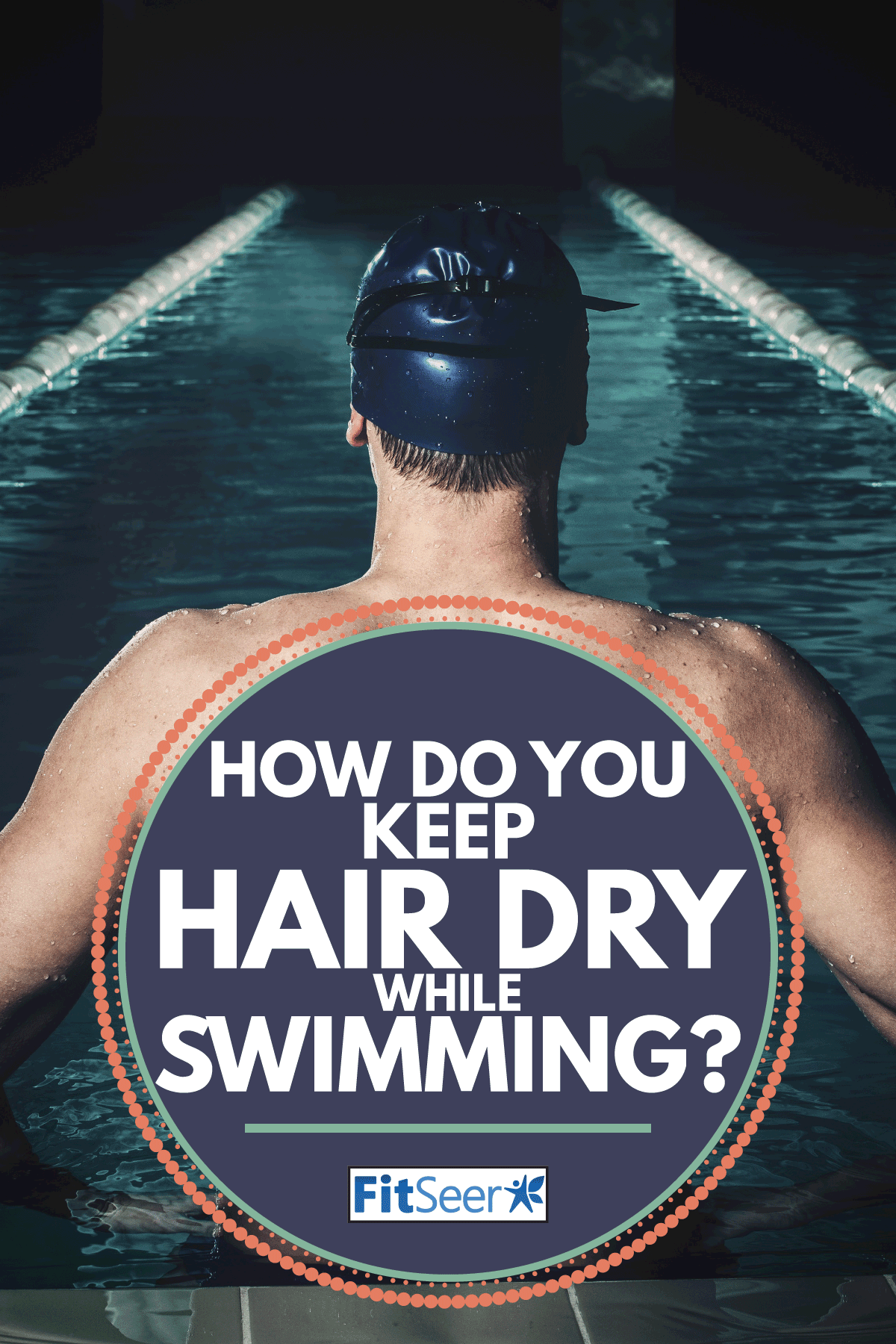Swimming is a sport that requires concentration and focus. It helps to keep that focus when your hair is dry and not in the way. But how are you supposed to keep your hair dry when you're in the water? We've done the research, and there's no guaranteed way to keep your hair dry while swimming unless you keep your head above water. However, you can protect your hair from getting completely soaked and from chlorine with a swim cap.
To keep your hair as dry as possible, follow these steps:
- Use natural oils or a special conditioner for a protective layer
- Wear a swim cap that best suits your hair texture
Continue reading to better understand how to protect your hair when swimming. We'll discuss each type of swim cap and how various materials can protect your hair and scalp while you swim. In case you aren't sure how to put on a swim cap or keep it secure, we've got you covered! And finally, will a swim cap improve your speed and should you layer caps? Read on!

Types of Swim Caps
If you search swim caps, you'll get so many kinds made of different materials. Although any swim cap protects your hair, each material is made for specific consumers. We'll discuss each material below.
Silicone Caps
If you swim often or competitively, you'll want to look into swim caps made of silicone. These caps are the most common and are the most durable. It's made to fit your head nicely without losing its elasticity, and it won't often snag your hair.
If you're looking for a budget-friendly option that still has great quality, check out the Speedo Unisex Adult swim cap. It has great stretch and durability, and it comes in various colors to match your style. There's also an option for swimmers with long hair.
Click here to view the product on Amazon.
Neoprene Caps
Have you ever wondered why some surfers wear wetsuits? That's to keep their bodies warm while in the cold water. Some of those wetsuits are made of neoprene. Swim caps made of neoprene serve the same purpose for your hair. Swimmers who swim in chilly bodies of water will want to look into swim caps made of neoprene.
One option to consider purchasing if you swim somewhere with low visibility is the TYR High Visibility swim cap. This cap will keep your head warm, will securely stay on, and can be spotted from far away, especially if you buy the yellow-colored one.
Click here to view the product on Amazon.
Lycra/Spandex Caps
The recreational swimmer will appreciate swim caps made of this material. Spandex caps are the most comfortable to wear compared to the others. However, water will flow inside the cap more easily. You also need to rinse it after use to maintain its longevity. Otherwise, the chlorine will gradually reduce its elasticity.
If you're recreationally swimming or need a cap you can wear underneath a second one, try the TYR Lycra cap. It's comfortable to wear, won't snag your hair, and can still boost your swimming performance.
Click here to view the product on Amazon.
Latex/rubber Caps
Caps of this material have been around for years. They're designed to fit very snugly to give your hair great protection. Compared to the other materials, this one is more difficult to put on. If you have a latex allergy, stay away from these kinds of swim caps.
If allergies aren't an issue, you can get the Speedo Solid Latex cap for a small few dollars. It's built to resist tears and rolling.
Click here to view the product on Amazon.
How Do I Put My Hair in a Swim Cap?
The main two challenges with swim caps are putting them on and their ability to stay on. That's why you need to properly follow these steps to keep your cap on tight. Because there are various materials, you may need to try each one to find the one best suited for you.
- If you have long hair, tie it in the back. Put it in a tight ponytail or bun so that it doesn't loosen while you swim.
- Wet your hair. The swim cap will slide over your hair easier when it's a little wet. When it's dry, the cap will stick to dry hair strands. [OPTIONAL] Use conditioner or apply some natural oil to add some water resistance to your hair. Water will still get in your hair, even with a swim cap. To avoid the damaging effects of chlorine, if swimming in a pool, applying conditioner or oil will give your hair the moisture it would significantly lose due to chlorine.
- Find the seam of the cap. For a good fit, the seam must be aligned right. The seam should wrap from the middle of your forehead to the bottom back of your neck. If it's a brand new cap, stretch it so it's not too tight.
- Open the cap and pull it over your head. Then pull it down so it covers your head entirely.
- Make adjustments as necessary. Sometimes, hair may still be loose. Tuck the exposed hair into the cap, so nothing is exposed.
- [OPTIONAL] Put another cap over the first one. Some cap materials work better alongside a cap of another material. It also increases protection from the water.
Do You Cover Your Ears With a Swim Cap?
Some people choose to cover their ears fully, partially, or not at all. For preventative reasons, we advise you to cover your full ear. That way, you reduce the risk of getting swimmer's ear. According to LiveStrong, swimmer's ear is an infection of the ear canal, characterized by itching, redness, discomfort, or drainage in the ear canal.
If you're concerned about getting swimmer's ear, avoid using lycra/spandex swim caps. These aren't waterproof. You can wear it if you have another swim cap of a different material on top.
For additional protection, use waterproof earplugs. Water will reach your ears no matter what. But earplugs will tremendously help in preventing water from entering your ear canal. Aqua Ears silicone earplugs can be worn comfortably while swimming.
Click here to view the product on Amazon.
How Do You Put a Swim Cap on a Child?
Parents know how challenging it can be to put clothes on their young children, especially when they don't sit still. It can be even more challenging to put a child's swim cap on. You should give your child a swim cap made of 100% silicone to wear. It's easier to tuck their hair in, and it won't cause discomfort when worn correctly.
To put the cap on your child's head, start by wetting their hair. Apply some conditioner if their hair gets tangled easily, so the cap is easier to slide on and off. Next, stretch the cap outwards and wide enough to fit your child's head. Have your child stand in front of you with their hair held up. Then, slide the cap on their head, lowering it until it covers all of their hair. Gently slide your fingers out and slide in any exposed hair into their cap.
After that, your child is ready to take a swim!
Do Silicone Swim Caps Pull Hair?
If swim caps are worn without factoring in our tips, the cap will likely pull your hair no matter its material. The initial dryness of your hair will get caught in the seam, irritating you as you swim.
However, if hair pulling is a concern, silicone caps are the best option. Compared to other materials, this is one of the comfier cap materials and is least susceptible to pulling. Its stretchiness conforms to your head's shape and smoothly stays in place. This doesn't mean that it won't ever pull your hair; it just won't pull nearly as often as other materials.
Do Lycra Swim Caps Protect Hair From Chlorine?
Swim caps made of Lycra are the more durable cap materials. It's the same material used in some swimsuits. Wearing one gives you a nice, uniform look. However, this isn't a good choice for protecting hair. Lycra swim caps are prone to slipping. So when you swim, it offers less protection from the water than other materials.
Even though it's more durable than other caps, don't use these caps for anything other than recreational use. You can also wear this along with a different cap. But by itself, it will not offer much protection from chlorine.
Why Do Swimmers Wear Two Caps?
If you've seen the Olympics, you've likely seen competitive swimmers wear more than one cap. They do this for two reasons:
Secure Goggles
The first is to wear goggles easier. The first swim cap is to protect their hair. Then they place their goggles on. The second swim cap is to keep the goggles in place as they swim. The rubber grip of the goggles and the caps prevent the goggles from sliding off.
Boost Performance
The second reason is to boost swimming performance. Swim caps are hydrodynamically designed to help swimmers move more swiftly. One cap --usually latex-- stays on your head better, while the second may slip off mid-swim. That second cap will also help reduce drag.
It's not required to wear two caps, but if it helps your performance, go for it! Consider how long the pool is before deciding to wear one or two swim caps.
How Much Faster Does a Swim Cap Make You?
People with longer hair are at a disadvantage when swimming without a cap. Their hair will soak up the water, causing a drag while swimming. Wearing a cap eliminates that drag if worn properly. A cap that covers all of your hair and lacks wrinkles will slightly increase your swim speed. If you swim competitively, wear a cap so you have a better shot at winning.
In Closing
Before your next swim, make sure you have the right swim cap that fits your head comfortably. It won't completely prevent your hair from getting wet, but it'll do a great job preventing chlorine from getting in your hair entirely.
Beginner swimmers should look into Lycra swim caps for a comfier experience. They also should look into our guide to learning how to swim.







![Read more about the article What Can I Use Instead of a Pilates Ring [7 Alternatives]](https://fitseer.com/wp-content/uploads/2022/01/Aerobic-Pilates-stuff-like-mat-balls-roller-magic-ring-rubber-bands-on-wooden-floor-500x333.jpg)
![Read more about the article How To Clean Football Gloves [A Complete Guide]](https://fitseer.com/wp-content/uploads/2021/12/A-football-player-wearing-white-football-gloves-and-holding-a-football-tightly-500x333.jpg)

![Read more about the article How Many Frames Are In A Game Of Bowling? [And How Long It Lasts]](https://fitseer.com/wp-content/uploads/2022/04/An-orange-bowling-ball-rolling-to-the-bowling-pins-500x333.jpg)
